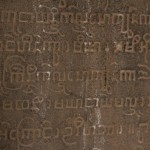Come and learn what to do and how, what not to do and even how what not to do, plus all the rest with our little team of font fanatics. We’ll be covering Thai, Lao, Burmese and Khmer with all the resources you need to get started on these scripts. And did we mention it’s by the beach in Hua Hin, Thailand? Continue reading
Tag Archives: Burmese
Indic inscriptions
Gallery

A selection of inscriptions from early times showing Pallava and its evolution into proto-Thai and proto-Burmese. Images in chronological order. More on Flickr: Burmese or Thai inscriptions.
Parallel thinking, parallel histories
Designing type is an exercise in parallel thinking. On one level, it’s about coming up with interesting ways to inject each letter with some visual interest and simultaneously respond to the brief chosen. But on another level, it’s about ‘designing the design’, as we’ve seen before. What is it about the letters that hangs them all together? How can a set of ideas be applied consistently and logically so that it can be called a design rather than just a set of shapes? The answer to that is one reason why to me, designing a text face is so sublime: it’s necessarily about eliminating everything that doesn’t gel with everything else, refining and reducing the idea behind it to its clearest, most elegant expression. Continue reading
Finally, Burmese begins to click
Our Spring term has flown by, and progress on my typeface was honestly a bit disappointing. Perhaps I tried to tackle too many things and ended up spreading things a bit thin with unresolved attempts at Greek and Thai, or perhaps it was the packed timetable of workshops, visiting lecturers and assessment deadlines, but I was expecting to have achieved more by the end of term. I was especially unhappy that I didn’t have very much new stuff to show Gerard in his two visits of the term, as I’d been focussing on the non-Latin designs rather than bold, italic or sans fonts I’m also trying to develop. On the plus side, however, my Latin lowercase in the regular weight is now accomplished, including most of the spacing, so I’m freezing that now to work on the caps and Burmese. Continue reading
The typographic tradition in non-Latin scripts
In Europe, the various strands of typography came together over centuries. Even before the arrival of printing, there were many styles (and sub-styles) of writing: the Greek and Roman inscriptional capitals and everyday ‘rustic’ letters, the Carolingian and insular uncials, and the textura and rotunda gothics to name only a few key elements. Printing types started in the fifteenth century by mimicking the forms of handwritten letters, and thenceforth, developments in type included bicameralism (including upper- and lowercase versions of letters in one typeface), the integration of uprights with italics, and the gradual movement away from humanist models to the elegant swelling lines of the “modern’ types. Later we see the introduction of sans-serif faces, and the invention of the fat, poster faces that gave us our bolds. Continue reading
Designing the design
There’s a phrase that pops up from time to time in the department; it’s probably a Gerry-ism. ‘Designing the design’.
My take on it is that before we start drawing letterforms and thinking about details like what style of serifs we’d like, there’s the important matter of how the thing should look holistically. Can I visualise the rhythm and texture on the page, the way the letters perform together? Am I aiming for a particular mood and tone? What connotations and atmospheric values would I like to suggest? Continue reading
Puzzlements and progress
Our first term is over, though it feels as though we’ve all only just settled in. The ten weeks have passed so quickly, in a flurry of workshops, conferences, seminars, critique sessions and typographic delights. I’m feeling lucky to be able to spend this year doing something I enjoy so much at a department with such a great name. Continue reading
Constructive confusion
Week 8 was our second intensive practical week with Gerard, and with only two more weeks of term, it’s felt like time to really settle into a definite direction and concentrate fully on our typefaces. Continue reading
Research-led design
The last couple of weeks have felt a little more pressured, as we concentrate more on our practical projects, delve more deeply into the non-Latin scripts and start our core seminars.
As well as classroom commitments, I have become the student representative for the class, which involves extra meetings both in the department and with the Students’ Union. The food situation near the Typography and Arts departments is pretty dire, so some sort of petition or direct action may be in order. There have also been a few silly problems with IT in the department which have needed more patience than expected.
False starts, confusion and learning
For the past two or three weeks I’ve been bashing out ideas for my practical project, the type family designed especially for Burmese dictionaries. As I blogged before (Thoughts on a Brief and Exploring Burmese), I’m aiming for a fresh, lively and cheerful design, in which the Burmese and Latin scripts harmonise well. Continue reading